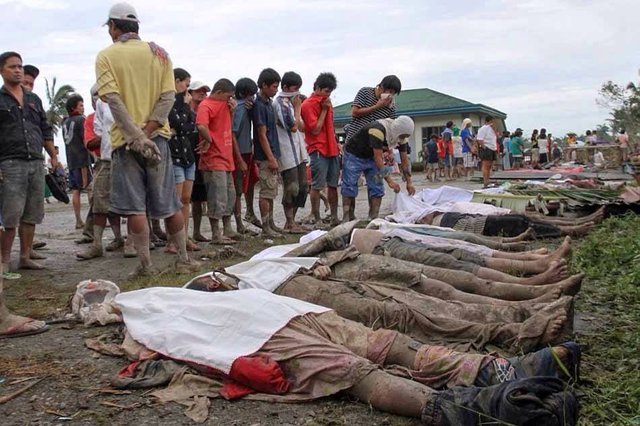Typhoon Haiyan, known as Super Typhoon Yolanda in the Philippines, was one of the most intense tropical cyclones on record, which devastated portions of Southeast Asia, particularly the Philippines, on November 8, 2013. Wikipedia
The Satelite image

The number of people dead or missing after one of the world's strongest typhoons struck the Philippines climbed towards 7,000 on Saturday, as the United Nations warned much more needed to be done to help desperate survivors.
The government's confirmed death toll rose to 5,235, with another 1,613 people still missing more than two weeks after Super Typhoon Yolanda (Haiyan) destroyed entire towns across a long stretch of islands in the central Philippines.
Yolanda now rivals a 1976 tsunami on the southern island of Mindanao as the deadliest recorded natural disaster to strike the Philippines, which endures a never-ending battle against typhoons, earthquakes, floods and volcanic eruptions.
The typhoon has triggered a giant, international aid effort, with dozens of countries and relief organizations rushing to deliver food, water and health services to more than four million people who lost their homes.
However UN humanitarian chief Valerie Amos, after visiting the disaster zones, warned the world was still not responding fast enough.
"Much more needs to be done. Food, clean water and shelter remain the top priorities," Amos said as a UN appeal for funds was raised from $301 million to $348 million.
Amos said huge numbers of people were still exposed to bad weather in the nine provinces ravaged by the storm, as she warned particularly of the dangers for babies, children and mothers.
"I am very concerned that some 1.5 million children are at risk of acute malnutrition and close to 800,000 pregnant and nursing mothers need nutritional help," Amos told a news conference at UN headquarters.
- See more at: http://www.gmanetwork.com/news/story/336799/news/nation/yolanda-death-toll-feared-to-hit-7-000#sthash.eqIAoqqL.dpuf

A raggedy cloth banner in a town torn apart by one of the most powerful typhoons on record declares that its residents are "roofless, homeless, but not hopeless."

Healing Yolanda's wounds to take years
Nevertheless, the poorly rebuilt homes are just band-aids over a gruesome wound that authorities say will take many years and billions of dollars to heal.
Most areas of the central Leyte and Samar islands that were the worst hit by Yolanda remain without electricity and supplies of drinking water.
And nearly three million people remain reliant on life-saving food aid or farming support, such as crop seeds, according to the United Nations.
People living in ruined communities along the sides of major roads on Leyte write messages on boards, such as: "Help us, we need food", in the hope of getting a relief truck to stop.
Yet, desperation should not always be confused for despair.
3 years after Typhoon Haiyan
Three years ago, the strongest typhoon ever known to make landfall ravaged the Philippines and triggered one of the world’s biggest humanitarian catastrophes and relief and recovery operations.
More than 16 million people were affected by Typhoon Haiyan (local name Yolanda), approximately 7,350 people died, 4.1 million were displaced and 1 million homes were destroyed.Losses were pegged at approximately $300 million.
Because most of the affected area was extremely impoverished, 1 in 3 families were especially vulnerable to loss of income and shelter.
The hardest hit areas, notably the Eastern Visayas region, experienced double-digit increases in poverty incidence.In addition to the colossal damage, Haiyan was extraordinary because video of the event and aftermath were streamed into living rooms and offices worldwide.
The dramatic storm surge — which caused the most devastation — was not predicted, but the typhoon’s direction and intensity was forecasted a couple days in advance, which allowed some media organizations to position themselves on the ground prior to the storm and share what they saw.
Other distressing footage was captured and revealed on individual smartphones and devices.






May they Rest in peace.